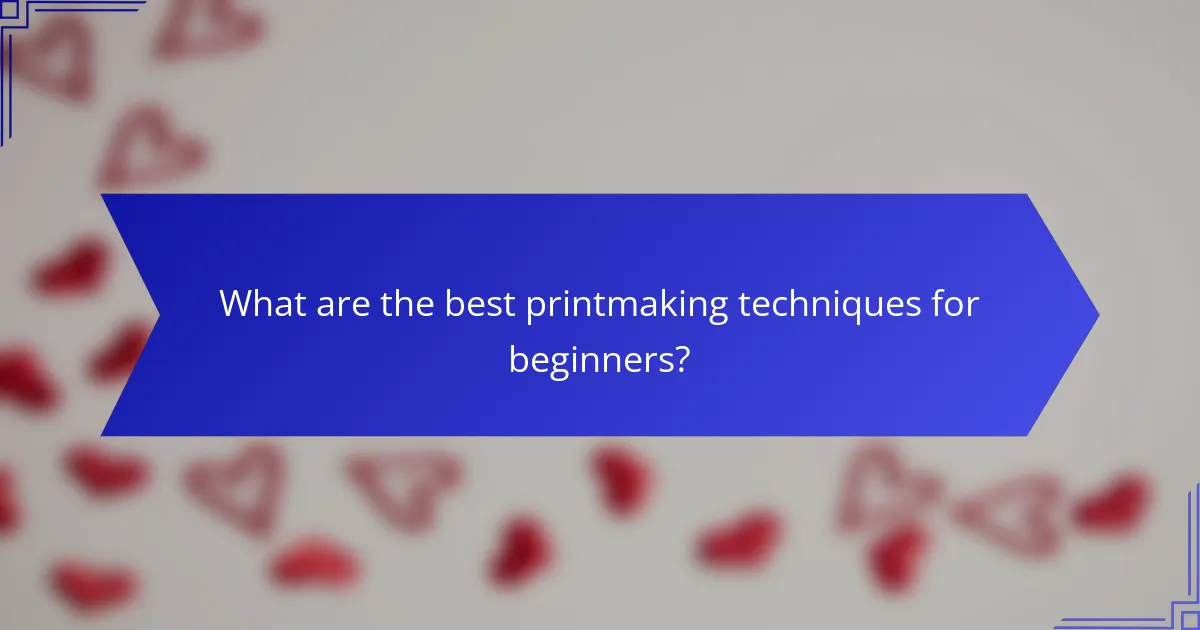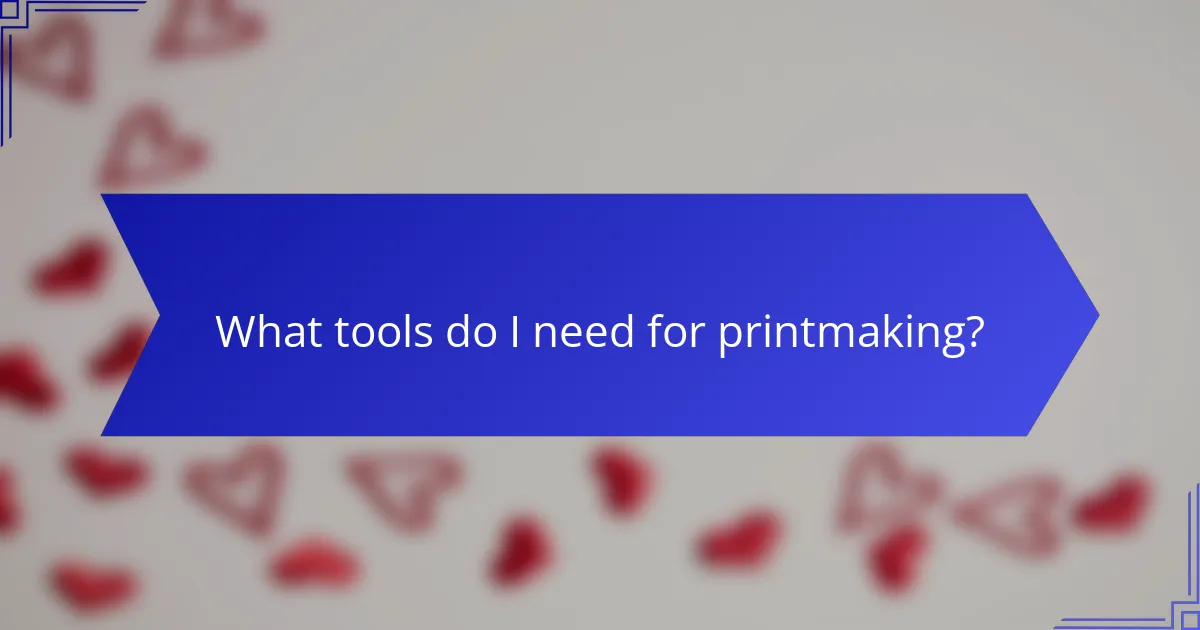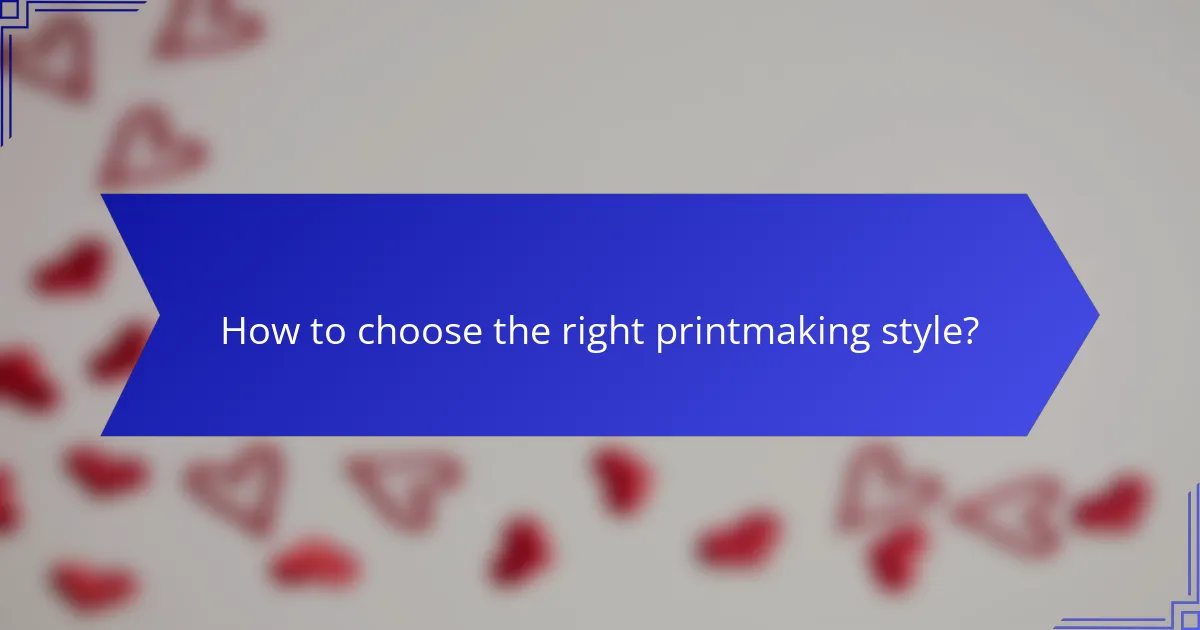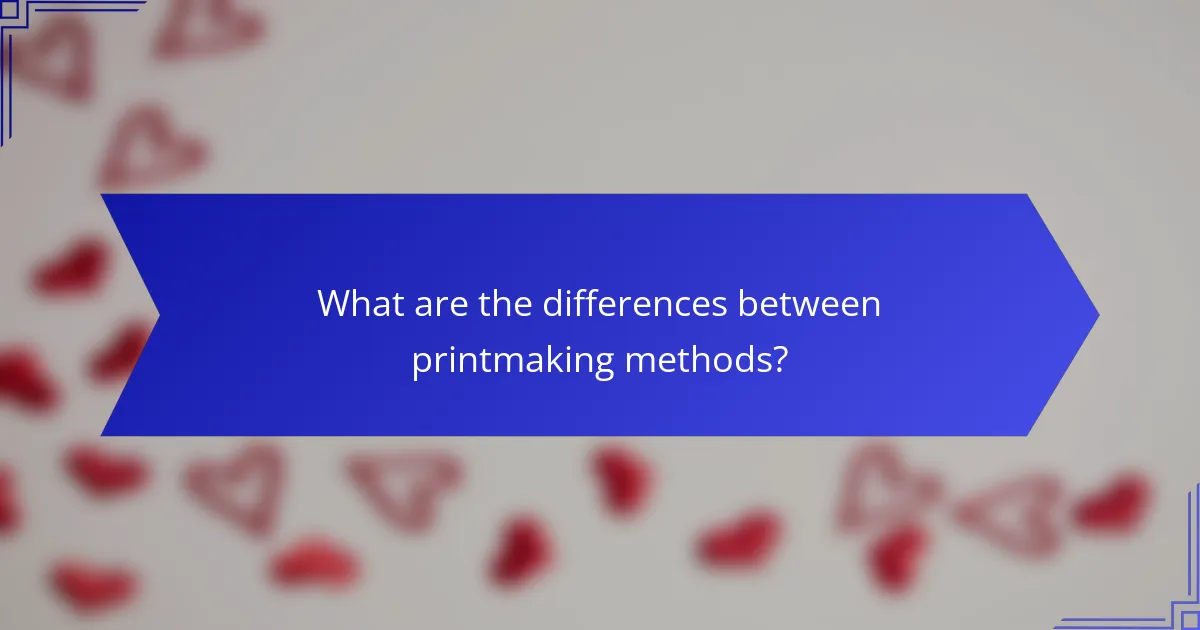Printmaking is a diverse art form that encompasses various techniques such as relief printing, screen printing, monotype, etching, and lithography, each offering unique processes and tools. Beginners can easily engage with these methods by utilizing essential tools like brayers, printing presses, and carving instruments. The choice of printmaking style is influenced by individual artistic goals, available resources, and personal preferences, allowing for a wide range of creative expression.

What are the best printmaking techniques for beginners?
For beginners, the best printmaking techniques include relief printing, screen printing, monotype, etching, and lithography. Each method offers unique processes and tools, making them accessible for those just starting out in the art of printmaking.
Relief printing
Relief printing involves carving a design into a material, typically wood or linoleum, where the raised areas are inked and pressed onto paper. This technique is straightforward and allows for bold, graphic images. Beginners can start with simple designs and gradually progress to more intricate patterns.
Common tools include carving knives and brayers for inking. A key tip is to ensure even pressure when printing to avoid uneven results. Practice with different materials to find what works best for your style.
Screen printing
Screen printing uses a mesh screen to transfer ink onto a surface, creating vibrant and layered images. This method is popular for textiles and posters, making it versatile for various projects. Beginners should start with simple designs and fewer colors to master the technique.
Essential tools include screens, squeegees, and inks. A common pitfall is using too much ink, which can lead to smudging. Experimenting with different fabrics can yield exciting results.
Monotype
Monotype is a unique printmaking technique where an image is painted or drawn onto a smooth surface and then transferred to paper, resulting in a one-of-a-kind print. This method encourages spontaneity and creativity, making it ideal for beginners looking to explore their artistic expression.
Tools needed include a flat surface, rollers, and paper. Since each print is singular, focus on experimenting with colors and textures. Keep in mind that the process can be messy, so prepare your workspace accordingly.
Etching
Etching is a printmaking process that involves using acid to carve designs into a metal plate. This technique allows for fine details and subtle textures, making it suitable for more advanced beginners. It requires some safety precautions due to the use of chemicals.
Basic tools include etching needles, acid baths, and printing presses. Start with simple line work to get accustomed to the process. Always wear gloves and work in a well-ventilated area to ensure safety.
Lithography
Lithography is based on the principle that oil and water do not mix. Artists draw on a flat stone or metal plate with a greasy medium, then apply ink, which adheres only to the drawn areas. This technique can produce rich, detailed prints and is great for those interested in drawing and painting.
Essential materials include lithographic stones or plates, special inks, and a press. Beginners should practice with simple designs and focus on the drawing technique. It’s important to keep the stone or plate clean to ensure quality prints.

What tools do I need for printmaking?
To start printmaking, you need a selection of essential tools that facilitate the process. Key items include brayers, printing presses, inks, paper types, and carving tools, each serving a specific purpose in creating prints.
Brayers
Brayers are handheld rollers used to apply ink evenly across a surface. They come in various sizes and materials, such as rubber or soft plastic, which affect the ink distribution. When selecting a brayer, consider the size of your printing plate and the type of ink you are using.
For best results, choose a brayer that matches the scale of your project. A wider brayer is suitable for larger plates, while a smaller one is ideal for detailed work. Always clean your brayer thoroughly after use to maintain its effectiveness.
Printing presses
A printing press is a crucial tool for producing high-quality prints, providing even pressure and consistent results. There are various types of presses, including etching presses, lithography presses, and letterpresses, each designed for specific techniques.
When selecting a printing press, consider the size and type of prints you plan to create. Smaller tabletop presses are great for beginners, while larger floor models are suited for more extensive projects. Ensure your press is compatible with the materials you intend to use.
Inks and pigments
Inks and pigments are vital for achieving the desired color and texture in your prints. Water-based inks are user-friendly and easy to clean, while oil-based inks offer richer colors and longer drying times. Choose inks based on your printing technique and personal preference.
Experimenting with different pigments can yield unique effects. Always check the manufacturer’s instructions for mixing and application to ensure optimal results. Keep in mind that some inks may require specific solvents for cleanup.
Paper types
The choice of paper significantly impacts the final print quality. Different types of paper, such as cotton rag, newsprint, and specialty printmaking papers, offer various textures and absorbencies. Selecting the right paper depends on your technique and desired finish.
For example, thicker papers work well for relief printing, while thinner papers are suitable for intaglio techniques. Always test your paper with your inks to see how they interact before committing to a larger project.
Carving tools
Carving tools are essential for creating designs in relief printmaking. Common tools include linoleum cutters, wood carving knives, and gouges, each designed for specific cutting techniques. A good set of carving tools allows for precision and detail in your prints.
When starting, invest in a basic set of tools and practice on softer materials like linoleum before moving to harder woods. Always carve away from your body for safety, and keep your tools sharp for clean cuts and better results.

How to choose the right printmaking style?
Choosing the right printmaking style depends on your artistic goals, available tools, time commitment, and personal preferences. Each style offers unique characteristics and techniques that can influence the final outcome of your artwork.
Consider your artistic goals
Your artistic goals play a crucial role in selecting a printmaking style. If you aim for intricate details, techniques like etching or lithography may suit you best. For bold, graphic designs, relief printing methods such as linocut or woodcut could be more appropriate.
Think about the message you want to convey and the audience you wish to reach. Different styles can evoke various emotions and responses, so align your choice with your creative vision.
Evaluate available tools
The tools you have access to can significantly influence your printmaking style. For instance, if you own a press, you might explore intaglio or lithography, while those with limited equipment may prefer simpler methods like monotype or block printing.
Consider the cost and availability of materials as well. Some techniques require specialized inks and papers, which can affect your budget and project feasibility.
Assess time commitment
Evaluate how much time you can dedicate to learning and practicing your chosen style. If you’re working on a tight schedule, opt for methods that allow for quicker results without sacrificing quality.
Explore personal preferences

What are the differences between printmaking methods?
Printmaking methods vary primarily in how they transfer ink to paper, impacting the final artwork’s texture and detail. Key methods include relief, intaglio, lithography, and screen printing, each with unique tools and techniques that influence the creative process.
Relief vs. intaglio
Relief and intaglio are two fundamental printmaking techniques distinguished by their ink transfer methods. In relief printing, the raised surfaces of a block or plate are inked, while in intaglio, ink is applied to the recessed areas, creating different visual effects and textures.
Relief printing, such as woodcut or linocut, is often more straightforward and accessible for beginners. Artists carve away parts of the block to create their image, allowing for bold lines and shapes. Intaglio, including etching and engraving, requires more specialized tools and techniques, resulting in finer details and subtle gradations in tone.
When choosing between relief and intaglio, consider the desired outcome. Relief prints tend to have a bolder, graphic quality, while intaglio prints offer intricate detail and depth. Both methods can be combined for unique results, but understanding their differences helps in selecting the right approach for your artistic vision.
